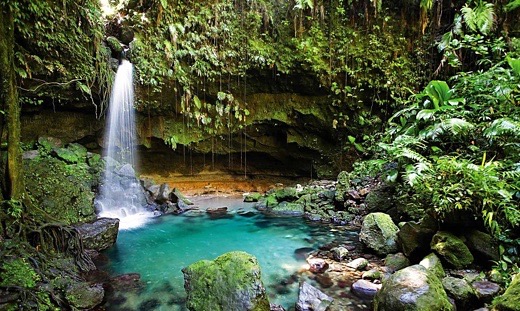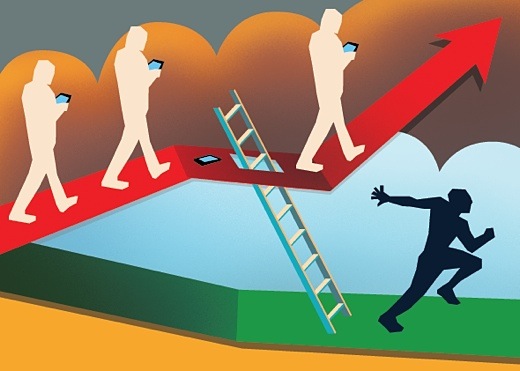SUBHEAD: The calls into question the solutions proposed by so-called renewable technologies.
By Edwardo Sasso 0n 7 May 2020 for Resilience -
(https://www.resilience.org/stories/2020-05-07/planet-of-the-humans-reviewing-the-film-and-its-reviews/)
Image above: This immense photovoltaic power plant is operated by an Italian company in the desert near Villanueva, Mexico. From (https://www.nbcnews.com/mach/science/supersized-solar-farms-are-sprouting-around-world-maybe-space-too-ncna901666).
[IB Publisher's comment: In our experience in Hawaii solar-electricity generation does not necessarily require the use of large quantities of cement and steel. The panels themselves often have aluminum frames. In Hawaii we have a corrugated metal roof. Our solar panels have aluminum frames bolted to 2"x4" wood frames that are bolted to the metal roofing. Small scale individual residential and commercial solar systems don't need high voltage distribution towers or heavy duty foundations and framing. We worry about hurricane damage... but that's likely to take the whole roof off.]
If you haven’t seen the latest (and arguably the most contentious) documentary on renewable energy, be prepared for an aftertaste of mixed feelings.
Joining hands with the controversial Michael Moore, environmentalist and filmmaker Jeff Gibbs has sent an eerie message that is now somewhat dividing the climate movement—in many ways for the worse, but, in a few others, for the better.
So, at least, one could argue is the case of Planet of the Humans. After engaging briefly with some of the well-deserved criticisms the film has received thus far, there are nevertheless some important aspects brought to our attention by the movie.
Specifically, at one point in the documentary, Gibbs touches upon the religious and existential dimensions underlying our ecological hot waters—aspects that, for what it seems, many of his critics have left unaddressed. Hence the focus towards the end of this review will fall on the cosmic role of religion (or cosmology, if we will) in helping us engage with “the great scheme of things”, to use the phrase of one of the scholars interviewed in the documentary.
But first a sketch of the film and its criticism.
What is the Central Claim of Planet of the Humans?
Drawing implicitly on the legacy of renowned environmentalist Rachel Carson, in essence, Planet of the Humans calls into question the solutions proposed by so-called renewable technologies.
Such solutions, Gibbs argues, are to a degree or another an extension-in-disguise of the same problems created by our technological society. For one, solar panels and wind towers still burn fuels to be produced; for another, they rely on copious amounts of minerals and rare earth metals.
More worryingly, what Gibbs calls “the narrow solution of green technology” keeps feeding the pockets of a smaller few at the expense of the greater rest, leaving underlying societal problems unattended.
Overall, the documentary thus aims to show how the creation of these panels and towers, as well as the burning of biofuels and biomass, are also problematic, albeit in different ways if compared with the fossil fuels they aim to displace. Old wine in new wineskins, in short.
“Is it possible” thus asks Gibbs, “for machines made by industrial civilization to save us from industrial civilization?” (17:10)
Even if he argues for an unnerving “no”, some of the film’s reviewers are ready to claim the opposite.
(Well-Deserved) Hot-Blooded Reactions
To begin with, Gibbs’s critics are quick to signal how the film’s downplaying of renewables is outdated. The dismissal of solar panels (14:45, a scene whose panels arguably date from 2008), for instance, is done on the ground of their inefficiency.
However, as leading environmental activist Bill McKibben answers back, engineers have done their job since in vastly improving this technology, making solar the cheapest way of generating energy today.
According to McKibben, since a panel now lasts (up to) three decades—taking four years to compensate for the energy it took to build it—90 percent of the power it then produces is carbon-emissions-free.
Moreover, others point out how the overall impacts across the lifecycle (to mine materials, build, transport, install, and uninstall) both solar PVs and wind towers is between 3 and 28 times lower than using, say, liquified natural gas for electricity production (natural gas is one of the less polluting forms of fossil fuels).
The Guardian, too, implicitly takes sides with furious scientists calling to take down the movie—not least because fact-checks are revealing the film’s slim evidence to back up some claims.
Getting Rid of the Mud-water, but Keeping the Baby
Besides valid reasons like the above, what struck me as most troubling was the grim and rather accusatory tone of the documentary. It’s also (to a considerable extent) polarizing, at times dismissing perhaps too easily the honest intentions of some well-meaning folk. (Sad but true; especially in an age of ecological breakdown when we need to unite despite our differences.)
Still, could the film’s field-splitting call to choose sides, be the method to its madness? Could its polarizing stance somehow serve Gibb’s insistence to untangle the ecological cause from the story of unceasing economic growth—even of so-called ‘green’ economic growth—that continues to dictate the north of our industrialized societies?
Senior Fellow of the Post-Carbon Institute and author of Afterburn: Societies Beyond Fossil Fuels, Richard Heinberg, agrees with the filmmakers in admitting how the belief that with ‘green’ investments and political will we’ll ultimately be able to build a green future is “an illusion that deserves shattering.”
According to Heinberg,
Read: Renewables? To an extent, yes; but far beyond: lifestyle change, and cutbacks—something that some environmentalists shy away from championing, admittedly for the tactical communication purpose of not losing their audience.
And yet, as Heinberg notes, “it’s a mistake to let marketing consultants sort truth from fiction for us”—a chief reason why Planet of the Humans doesn’t have space for such bargaining.
Just Give Me (One More) Fact
On a similar vein, world-renowned Professor Emeritus of Community Planning at the University of British Columbia, William Rees, has recently shown the limitations of renewables and remains a pessimist facing what he labels as a “superficial support for the notion that green tech is our savior.”
To back his claim, Rees points out how building just one typical wind turbine requires 817 energy-intensive tonnes of steel, 2,270 tonnes of concrete, and 41 tonnes of non-recyclable plastic.
In turn, solar power also demands large quantities of cement, steel, and glass—let alone rare earth metals. Aside from their compromised mining and refining processes, world demand for such metals of so-called renewable energy would rise 300 percent to 1,000 percent by 2050 just to meet the Paris goals.
“Ironically,” Rees remarks, “the mining, transportation, refining and manufacturing of material inputs to the green energy solution would be powered mainly by fossil fuels.”
For all we’d like them to, towers and panels don’t simply drop from heaven. So, too, more or less argues the film.
Fact-checking and physical limitations aside, a deeper and more fundamental issue that Planet of the Humans unveils is that of the societal story that we continue to tell ourselves, in one shape or another—be it green, orange, right, left, or center.
And it’s the 300-year-old, now-taken-for-granted story of our increasingly urbanized, Techno-Industrial Age: namely, that we are the captains of our souls and the masters of our fates, and that we attain that fate through technology, production, and consumption.
In short, this societal narrative (including many ‘green’ versions of such narrative) has made us believe that we are above, front-and-center, while everything else is below, in the backstage.
Under this worldview, ‘nature’ is not a ‘Home’ but a ‘resource’; we are not earthly humans but technological ‘citizens’ (and now virtual ‘Internauts’); countries are not made of communities of earth-dwellers but of abstract ‘markets’ of X or Y number of ‘consumers’. And thus our very language betrays us.
Scholars call this ‘anthropocentrism’ blended with ‘economism’. Others label it ‘speciesism’ and ‘technopoly’, even as one corporation praised it by making us sing “You got the whole world in your hands, with Mastercard at your command.”
As materialist historian Yuval Noah Harari has shown in the sixteenth chapter of Sapiens, this story championed by today’s economic system has become so pervasive that it now has all the elements of religion—however secular its scope.
It tells us what to believe (economic growth will lead to the benefit of all), how to behave (rational and disciplined at the workplace, unrestrained and narcissistic at the shopping mall), and what to value (“Life is Now”, as Visa trumpeted rather conveniently, and dogmatically).
Hence to culture and religion we now turn—and to their characteristic interest in “the great scheme of things”.
Remixed Echoes of an Even-Older Story
In one of the most existential sections of the documentary (49:04), the director asks whether our inability to come to terms with our mortality misinforms most of our societal decisions. He also asks rhetorically whether his side (the environmental side) has an unspoken religion, even as the Right has Christianity and a belief in infinite fossil fuels.
I would nuance this second claim—at least pertaining to the so-called religion of (many) of the Right. And that because such a belief system is often in fact Deist. (Deism is a modern distortion of ancient Christianity, presenting us with a deity that’s detached from the world, which is then purportedly left for us to control as we discover and master its immutable laws.)
It is not my aim here to make a case for believing in a transcendental Agent, but simply to acknowledge how director Jeff Gibbs might be unknowingly inviting us to shed the same tears of the God testified to and experienced by the descendants of the ancient Hebrews.
In contrast to the absent deity of Deism, the sixth chapter of the Book of Genesis, for instance, speaks of the Most High becoming “regretful” considering the evil doings of humankind—something that “grieved God to his heart”.
According to the Book of Jeremiah, the Eternal One recoiled and was immersed in swirls of grief as people became strangers in their own land. In fact, in and through the cry of that young Hebrew prophet, God wept (Jer 14).
A Prophet in the Making?
haps, one of the film’s greatest contributions: its invitation to mourn, to leave us with discomfort towards superficial solutions, to invite us to feel and experience grief? However somberly and imperfectly, Gibbs may as well be helping us to traverse an unavoidable but ultimately necessary dark valley—one where we are reminded of how, before any blink of light, we must first confess and turn away from our pathological complicity with the decimation of our sacred Home. Genuine tears are the only cradle of authentic beginnings.
Even if commonly dismissed by large strands of the scientific and humanist communities in our scientific age, here lays one of the fundamental insights of what we call ‘religion’ or ‘spirituality’; namely, their ability to disclose the ultimate horizons that should inform and inspire our lives.
Such horizons have been barred by the smokescreens created by the Industrial Revolution, tempting us not to see anywhere beyond. (Who needs to pray for rain for crops when one is a click away from a Caesar’s salad or a Papa John’s pizza?)
For numerous reasons, for the past three centuries we’ve increasingly come to believe that there’s no ultimate purpose or ‘goal’ to life. Instead, all we’ve been left with is an unrestrained desire to impose our will upon others and upon the living world, as it’s now tragically evident. When ultimate purposes vanish out of sight, we strive to become gods.
Recovering Forgotten Horizon
Intentionally or not, the film’s sorrowful approach begins to dismantle this very ‘scheme of things’; one that has made us believe that we are alone, at the center, in control of an inert universe without ultimate meaning.
In contrast, the forgotten grand-view cracked open by ancient spiritual traditions summon us to acknowledge ourselves as guests in a world that precedes us and that is not our own. The spotlight falls elsewhere.
At least according to the Judeo-Christian tradition that now unspokenly undergirds pretty much all of today’s secularized Western cultures, we are mortal tenants and fragile earthlings; accountable, dependent, small. We are animated by sacred breath, even as we are made from the very dust to which we will return.
But, precisely as such, we are nevertheless invited into an extravagant feast hosted by the Ultimate Source of completeness, gladness, and joy—the very Source who also cries and grieves.
Is such plenitude the hidden treasure that we are most searching for today—left, right, or center? Far beyond any technical glitch that we can muster, isn’t such plenitude the very ‘something’ which we know in our bones to be ultimately missing?
Those, of course, are questions for another occasion. And they may seem trivial should we continue to dismiss the divine and the transcendental as sheer social constructions that our human ancestors invented back in yesteryear to soothe our consciousness.
But then we must ask, how far will the dogmas of Materialism continue to take us? As posed by one of the film’s social scientists: “If we’re to make progress (whatever that word means). . . we’re going to radically overhaul our basic conception of who and what we are and what it is that we value.”
Or to borrow the words from Albert Einstein:
Not unlike Einstein’s summons, Planet of the Humans is at least spot on about the need to turn away from our technocentric story and all its delusions that have claimed to give us full control. Then, and only then, will any light shine like the dawn. And perhaps then, and only then, will we humans realize ourselves as transient guests on a planet that is certainly not of our own making.
Our tears will not be in vain.
.
By Edwardo Sasso 0n 7 May 2020 for Resilience -
(https://www.resilience.org/stories/2020-05-07/planet-of-the-humans-reviewing-the-film-and-its-reviews/)

Image above: This immense photovoltaic power plant is operated by an Italian company in the desert near Villanueva, Mexico. From (https://www.nbcnews.com/mach/science/supersized-solar-farms-are-sprouting-around-world-maybe-space-too-ncna901666).
[IB Publisher's comment: In our experience in Hawaii solar-electricity generation does not necessarily require the use of large quantities of cement and steel. The panels themselves often have aluminum frames. In Hawaii we have a corrugated metal roof. Our solar panels have aluminum frames bolted to 2"x4" wood frames that are bolted to the metal roofing. Small scale individual residential and commercial solar systems don't need high voltage distribution towers or heavy duty foundations and framing. We worry about hurricane damage... but that's likely to take the whole roof off.]
If you haven’t seen the latest (and arguably the most contentious) documentary on renewable energy, be prepared for an aftertaste of mixed feelings.
Joining hands with the controversial Michael Moore, environmentalist and filmmaker Jeff Gibbs has sent an eerie message that is now somewhat dividing the climate movement—in many ways for the worse, but, in a few others, for the better.
So, at least, one could argue is the case of Planet of the Humans. After engaging briefly with some of the well-deserved criticisms the film has received thus far, there are nevertheless some important aspects brought to our attention by the movie.
Specifically, at one point in the documentary, Gibbs touches upon the religious and existential dimensions underlying our ecological hot waters—aspects that, for what it seems, many of his critics have left unaddressed. Hence the focus towards the end of this review will fall on the cosmic role of religion (or cosmology, if we will) in helping us engage with “the great scheme of things”, to use the phrase of one of the scholars interviewed in the documentary.
But first a sketch of the film and its criticism.
What is the Central Claim of Planet of the Humans?
Drawing implicitly on the legacy of renowned environmentalist Rachel Carson, in essence, Planet of the Humans calls into question the solutions proposed by so-called renewable technologies.
Such solutions, Gibbs argues, are to a degree or another an extension-in-disguise of the same problems created by our technological society. For one, solar panels and wind towers still burn fuels to be produced; for another, they rely on copious amounts of minerals and rare earth metals.
More worryingly, what Gibbs calls “the narrow solution of green technology” keeps feeding the pockets of a smaller few at the expense of the greater rest, leaving underlying societal problems unattended.
Overall, the documentary thus aims to show how the creation of these panels and towers, as well as the burning of biofuels and biomass, are also problematic, albeit in different ways if compared with the fossil fuels they aim to displace. Old wine in new wineskins, in short.
“Is it possible” thus asks Gibbs, “for machines made by industrial civilization to save us from industrial civilization?” (17:10)
Even if he argues for an unnerving “no”, some of the film’s reviewers are ready to claim the opposite.
(Well-Deserved) Hot-Blooded Reactions
To begin with, Gibbs’s critics are quick to signal how the film’s downplaying of renewables is outdated. The dismissal of solar panels (14:45, a scene whose panels arguably date from 2008), for instance, is done on the ground of their inefficiency.
However, as leading environmental activist Bill McKibben answers back, engineers have done their job since in vastly improving this technology, making solar the cheapest way of generating energy today.
According to McKibben, since a panel now lasts (up to) three decades—taking four years to compensate for the energy it took to build it—90 percent of the power it then produces is carbon-emissions-free.
Moreover, others point out how the overall impacts across the lifecycle (to mine materials, build, transport, install, and uninstall) both solar PVs and wind towers is between 3 and 28 times lower than using, say, liquified natural gas for electricity production (natural gas is one of the less polluting forms of fossil fuels).
The Guardian, too, implicitly takes sides with furious scientists calling to take down the movie—not least because fact-checks are revealing the film’s slim evidence to back up some claims.
Getting Rid of the Mud-water, but Keeping the Baby
Besides valid reasons like the above, what struck me as most troubling was the grim and rather accusatory tone of the documentary. It’s also (to a considerable extent) polarizing, at times dismissing perhaps too easily the honest intentions of some well-meaning folk. (Sad but true; especially in an age of ecological breakdown when we need to unite despite our differences.)
Still, could the film’s field-splitting call to choose sides, be the method to its madness? Could its polarizing stance somehow serve Gibb’s insistence to untangle the ecological cause from the story of unceasing economic growth—even of so-called ‘green’ economic growth—that continues to dictate the north of our industrialized societies?
Senior Fellow of the Post-Carbon Institute and author of Afterburn: Societies Beyond Fossil Fuels, Richard Heinberg, agrees with the filmmakers in admitting how the belief that with ‘green’ investments and political will we’ll ultimately be able to build a green future is “an illusion that deserves shattering.”
According to Heinberg,
“The only realistic way to make the transition in industrial countries like the US is to begin reducing overall energy usage substantially [solar-/wind-powered or otherwise], eventually running the economy on a quarter, a fifth, or maybe even a tenth of current energy.”
Read: Renewables? To an extent, yes; but far beyond: lifestyle change, and cutbacks—something that some environmentalists shy away from championing, admittedly for the tactical communication purpose of not losing their audience.
And yet, as Heinberg notes, “it’s a mistake to let marketing consultants sort truth from fiction for us”—a chief reason why Planet of the Humans doesn’t have space for such bargaining.
Just Give Me (One More) Fact
On a similar vein, world-renowned Professor Emeritus of Community Planning at the University of British Columbia, William Rees, has recently shown the limitations of renewables and remains a pessimist facing what he labels as a “superficial support for the notion that green tech is our savior.”
To back his claim, Rees points out how building just one typical wind turbine requires 817 energy-intensive tonnes of steel, 2,270 tonnes of concrete, and 41 tonnes of non-recyclable plastic.
In turn, solar power also demands large quantities of cement, steel, and glass—let alone rare earth metals. Aside from their compromised mining and refining processes, world demand for such metals of so-called renewable energy would rise 300 percent to 1,000 percent by 2050 just to meet the Paris goals.
“Ironically,” Rees remarks, “the mining, transportation, refining and manufacturing of material inputs to the green energy solution would be powered mainly by fossil fuels.”
For all we’d like them to, towers and panels don’t simply drop from heaven. So, too, more or less argues the film.
Fact-checking and physical limitations aside, a deeper and more fundamental issue that Planet of the Humans unveils is that of the societal story that we continue to tell ourselves, in one shape or another—be it green, orange, right, left, or center.
And it’s the 300-year-old, now-taken-for-granted story of our increasingly urbanized, Techno-Industrial Age: namely, that we are the captains of our souls and the masters of our fates, and that we attain that fate through technology, production, and consumption.
In short, this societal narrative (including many ‘green’ versions of such narrative) has made us believe that we are above, front-and-center, while everything else is below, in the backstage.
Under this worldview, ‘nature’ is not a ‘Home’ but a ‘resource’; we are not earthly humans but technological ‘citizens’ (and now virtual ‘Internauts’); countries are not made of communities of earth-dwellers but of abstract ‘markets’ of X or Y number of ‘consumers’. And thus our very language betrays us.
Scholars call this ‘anthropocentrism’ blended with ‘economism’. Others label it ‘speciesism’ and ‘technopoly’, even as one corporation praised it by making us sing “You got the whole world in your hands, with Mastercard at your command.”
As materialist historian Yuval Noah Harari has shown in the sixteenth chapter of Sapiens, this story championed by today’s economic system has become so pervasive that it now has all the elements of religion—however secular its scope.
It tells us what to believe (economic growth will lead to the benefit of all), how to behave (rational and disciplined at the workplace, unrestrained and narcissistic at the shopping mall), and what to value (“Life is Now”, as Visa trumpeted rather conveniently, and dogmatically).
Hence to culture and religion we now turn—and to their characteristic interest in “the great scheme of things”.
Remixed Echoes of an Even-Older Story
In one of the most existential sections of the documentary (49:04), the director asks whether our inability to come to terms with our mortality misinforms most of our societal decisions. He also asks rhetorically whether his side (the environmental side) has an unspoken religion, even as the Right has Christianity and a belief in infinite fossil fuels.
I would nuance this second claim—at least pertaining to the so-called religion of (many) of the Right. And that because such a belief system is often in fact Deist. (Deism is a modern distortion of ancient Christianity, presenting us with a deity that’s detached from the world, which is then purportedly left for us to control as we discover and master its immutable laws.)
It is not my aim here to make a case for believing in a transcendental Agent, but simply to acknowledge how director Jeff Gibbs might be unknowingly inviting us to shed the same tears of the God testified to and experienced by the descendants of the ancient Hebrews.
In contrast to the absent deity of Deism, the sixth chapter of the Book of Genesis, for instance, speaks of the Most High becoming “regretful” considering the evil doings of humankind—something that “grieved God to his heart”.
According to the Book of Jeremiah, the Eternal One recoiled and was immersed in swirls of grief as people became strangers in their own land. In fact, in and through the cry of that young Hebrew prophet, God wept (Jer 14).
A Prophet in the Making?
haps, one of the film’s greatest contributions: its invitation to mourn, to leave us with discomfort towards superficial solutions, to invite us to feel and experience grief? However somberly and imperfectly, Gibbs may as well be helping us to traverse an unavoidable but ultimately necessary dark valley—one where we are reminded of how, before any blink of light, we must first confess and turn away from our pathological complicity with the decimation of our sacred Home. Genuine tears are the only cradle of authentic beginnings.
Even if commonly dismissed by large strands of the scientific and humanist communities in our scientific age, here lays one of the fundamental insights of what we call ‘religion’ or ‘spirituality’; namely, their ability to disclose the ultimate horizons that should inform and inspire our lives.
Such horizons have been barred by the smokescreens created by the Industrial Revolution, tempting us not to see anywhere beyond. (Who needs to pray for rain for crops when one is a click away from a Caesar’s salad or a Papa John’s pizza?)
For numerous reasons, for the past three centuries we’ve increasingly come to believe that there’s no ultimate purpose or ‘goal’ to life. Instead, all we’ve been left with is an unrestrained desire to impose our will upon others and upon the living world, as it’s now tragically evident. When ultimate purposes vanish out of sight, we strive to become gods.
Recovering Forgotten Horizon
Intentionally or not, the film’s sorrowful approach begins to dismantle this very ‘scheme of things’; one that has made us believe that we are alone, at the center, in control of an inert universe without ultimate meaning.
In contrast, the forgotten grand-view cracked open by ancient spiritual traditions summon us to acknowledge ourselves as guests in a world that precedes us and that is not our own. The spotlight falls elsewhere.
At least according to the Judeo-Christian tradition that now unspokenly undergirds pretty much all of today’s secularized Western cultures, we are mortal tenants and fragile earthlings; accountable, dependent, small. We are animated by sacred breath, even as we are made from the very dust to which we will return.
But, precisely as such, we are nevertheless invited into an extravagant feast hosted by the Ultimate Source of completeness, gladness, and joy—the very Source who also cries and grieves.
Is such plenitude the hidden treasure that we are most searching for today—left, right, or center? Far beyond any technical glitch that we can muster, isn’t such plenitude the very ‘something’ which we know in our bones to be ultimately missing?
Those, of course, are questions for another occasion. And they may seem trivial should we continue to dismiss the divine and the transcendental as sheer social constructions that our human ancestors invented back in yesteryear to soothe our consciousness.
But then we must ask, how far will the dogmas of Materialism continue to take us? As posed by one of the film’s social scientists: “If we’re to make progress (whatever that word means). . . we’re going to radically overhaul our basic conception of who and what we are and what it is that we value.”
Or to borrow the words from Albert Einstein:
“A human being is part of the whole, called by us ‘Universe’; a part limited in time and space. He experiences himself, his thoughts and feelings as something separated from the rest—a kind of optical delusion of his consciousness. . . . Our task must be to free ourselves from this prison by widening our circle of compassion to embrace all living creatures and the whole of nature in its beauty.”
Not unlike Einstein’s summons, Planet of the Humans is at least spot on about the need to turn away from our technocentric story and all its delusions that have claimed to give us full control. Then, and only then, will any light shine like the dawn. And perhaps then, and only then, will we humans realize ourselves as transient guests on a planet that is certainly not of our own making.
Our tears will not be in vain.
.
